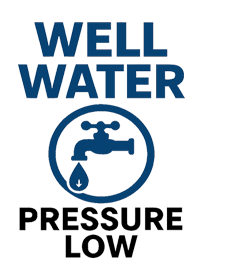Imagine your well pump as a reliable engine, powering the water that flows through your home. It works tirelessly, day in and day out, to ensure that your taps never run dry. But what happens when this engine stalls due to well water pressure low? The pump shuts down, leaving you with nothing but an empty, silent system. It’s as if the heart of your water supply has skipped a beat.

When low pressure triggers a shutdown, it’s like the system’s defense mechanism kicking in—protecting itself from damage. But once the pressure has returned to normal, the next step is resetting the pump, bringing it back to life like rebooting a frozen computer. Let’s take a closer look at how you can reset your well pump after a low pressure shutdown.
Steps to Reset a Well Pump After Low Pressure Shutdown
1. Identify the Cause of Low Pressure
Before diving into the reset, it’s important to identify why the pump shut down in the first place. Low water pressure is often the culprit, but it can stem from various issues like a clogged pressure switch, a faulty pump, or even a waterlogged pressure tank. It’s essential to understand the root cause to ensure you don’t reset the system without addressing the underlying problem.
If the cause of low pressure is not addressed, it’s like trying to restart an engine with a leaking fuel tank—the issue will likely return. So, first, check the pressure gauge and make sure the tank has adequate pressure (typically 40-60 PSI). If the pressure is below this range, it could be the reason for the shutdown.
2. Turn Off the Power to the Well Pump
Safety is your first priority when working with electrical systems. Just like you wouldn’t try to fix a car engine without turning off the ignition, you should always cut the power before you attempt to reset the pump. Locate the circuit breaker or the switch that powers the well pump and turn it off to avoid any potential electrical hazards.

3. Inspect the Pressure Switch
The pressure switch is the brain of your well pump system, controlling the on-and-off function based on water pressure. Over time, dirt, rust, or debris can cause the switch to become clogged, preventing it from functioning correctly. Think of the pressure switch as the door to your pump—if it’s blocked, the pump can’t get in.
If your system is experiencing well water pressure low without obvious cause, clean the switch terminals using a wire brush or replace the switch if it’s damaged. This is an easy and inexpensive way to restore proper function.
4. Check the Pressure Tank
A waterlogged pressure tank is often the silent culprit behind a pressure drop. Like a sponge that’s saturated beyond its capacity, a waterlogged tank struggles to store and release pressure, causing the pump to work harder. If you suspect a waterlogged tank, drain the tank and recharge it with air. Check the air valve and adjust it to the recommended PSI for your system. If the bladder inside the tank is damaged, consider replacing the tank altogether.
5. Restore Power and Reset the Pump
Once you’ve addressed the potential causes of low pressure, it’s time to reset the pump. After turning the power back on at the circuit breaker, you can either manually reset the pressure switch or rely on the system to automatically restart once the pressure returns to normal.
Listen for the sound of the pump starting up—just like the hum of a car engine coming back to life. If everything is in working order, the pump should resume its normal operation, and your well water pressure low issue will be resolved.
6. Test the System
Turn on a faucet to check the water flow. If the flow is steady and consistent, your well pump has been successfully reset. If you’re still experiencing well water pressure low, you may need to troubleshoot further or call a professional for help.
Objections & Answers
Objection 1: “What if my pump shuts down often due to low pressure? Can I just keep resetting it?”
Answer: While resetting the pump may temporarily restore water pressure, frequent shutdowns indicate an underlying issue that needs attention. Continuously resetting the pump without addressing the root cause—like a waterlogged tank or a faulty pressure switch—can damage the system over time. Think of it like ignoring a warning light in your car—while the car may keep running for a while, the issue will worsen, potentially leading to costly repairs later.
Objection 2: “Is it safe to reset the pump myself? I don’t have much experience with plumbing.”
Answer: If you’re unfamiliar with working around electrical or water systems, it’s always best to call in a professional. Resetting a well pump isn’t overly complicated, but safety should always come first. Like handling any machine, following proper procedures and knowing your limits is key. A professional can inspect your system, reset it properly, and ensure everything is functioning as it should be.
Objection 3: “Why do I need to check the pressure tank? Isn’t the pump the only important part?”
Answer: The pressure tank is just as crucial as the pump itself. It plays a key role in maintaining pressure and ensuring that water flows consistently. If the tank is malfunctioning, it can cause well water pressure low and make the pump work harder. Addressing issues with the pressure tank first will help you avoid unnecessary pump stress and prevent future shutdowns.
Objection 4: “What if the well water pressure low issue doesn’t go away after resetting the pump?”
Answer: If resetting the pump doesn’t resolve the issue, there may be more complex problems at play, such as a failed pump motor, damaged pipes, or inadequate water supply. It’s important to call a professional to inspect the system thoroughly. Think of it like trying to troubleshoot an electrical issue with a flashlight—sometimes you need a more powerful tool to get to the heart of the problem.
The Benefits of Proper Resetting and Maintenance
Prevention of Further Damage – By resetting the pump correctly and addressing the root cause of low pressure, you’ll prevent long-term damage to the pump and pressure system.
Restored Water Flow – With the pump back in action, you can enjoy a steady flow of water once again, without interruptions.
Increased Pump Longevity – Proper maintenance and resetting help ensure that your pump works efficiently for years to come, saving you from costly replacements.
Peace of Mind – Knowing that your system is in good working order brings peace of mind, and ensures a steady supply of water for your home.
Bringing Your Pump Back to Life
Resetting a well pump after a low pressure shutdown is like restarting the engine of a stalled car—it’s essential to get the system running smoothly again. By identifying the cause of the well water pressure low issue, inspecting key components like the pressure switch and tank, and following the proper reset procedure, you can restore water flow to your home and keep the engine of your well system running smoothly.
If you encounter persistent issues, don’t hesitate to seek professional help. With the right care and attention, your well pump will keep pumping, ensuring that your home has access to fresh, reliable water whenever you need it.
